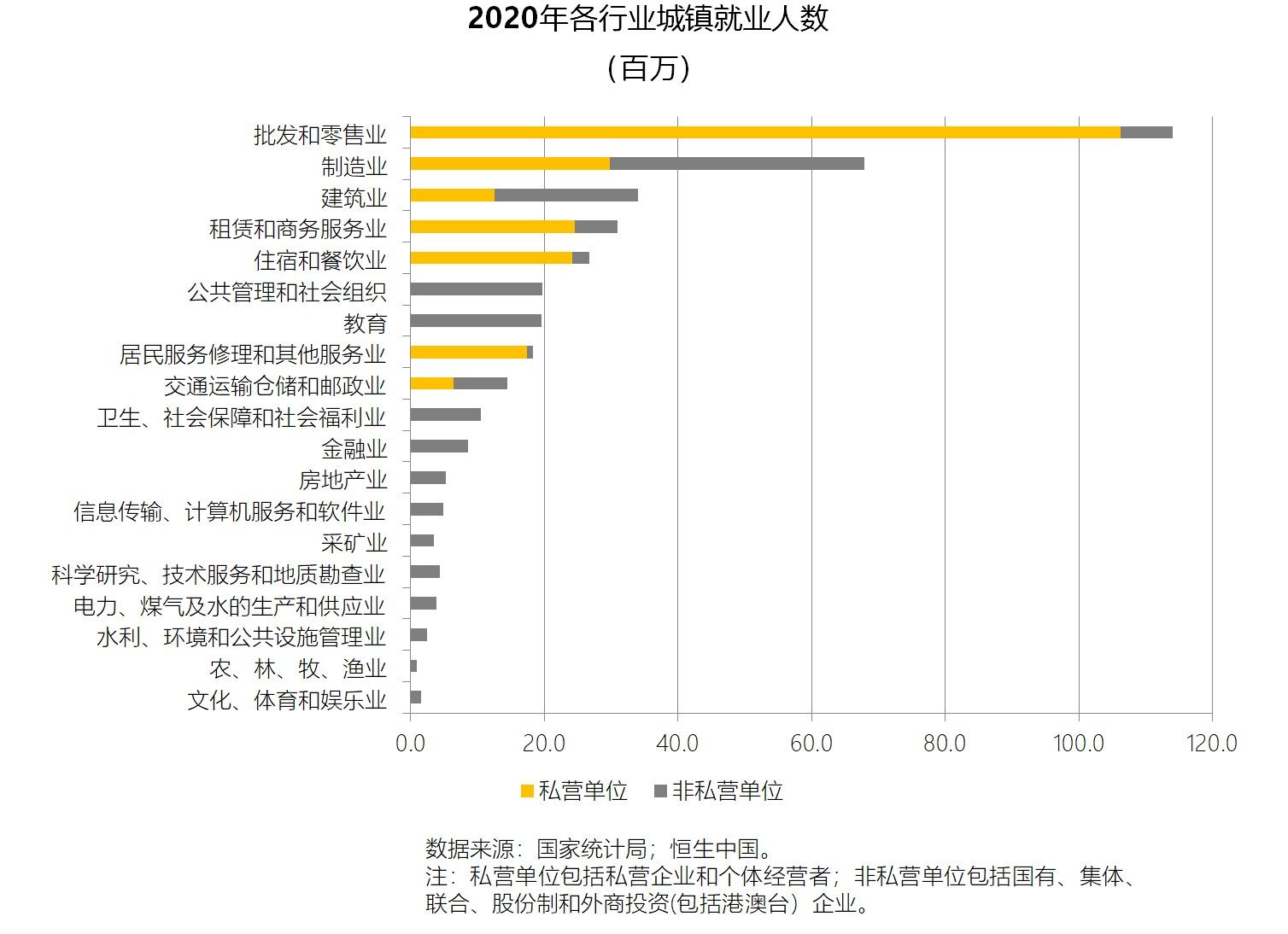Reminder from FTChinese.com: If you are interested in the content of FTChinese.com, please search for “FTChinese.com” in the Apple App Store or Huawei App Store, download the official app of FTChinese.com, and pay for subscription. Happy using!
Job market pressures are rising. The urban surveyed unemployment rate was 5.5% in February, hitting the upper end of the official target. Unemployment usually falls as factories and companies open in March. However, the situation in March this year was not optimistic. The Russian-Ukrainian war pushed up the price of raw materials, and many factories were forced to suspend production to reduce losses. In isolation and closed state, normal business operations and consumption have been hit hard.
About Statistics
With regard to the official unemployment data, a few things need to be clarified. First, there are two sets of indicators for urban unemployment statistics. The first set is roughly calculated based on the number of people receiving unemployment insurance. The number has been counted since 1978 and has hovered around 4% all year round. It does not reflect the overall employment pressure, but more reflects the situation of the most difficult urban unemployed. In order to better reflect the actual employment situation, the National Bureau of Statistics began to survey the urban survey unemployment rate according to the sampling statistical method from 2018. According to this indicator, the highest unemployment rate occurred in February 2020, rising to 6.2% due to the epidemic, but under normal circumstances it is less than 5.5%.
Second, when the government announces the unemployment rate in the middle of each month, it only announces the urban unemployment rate, and rural residents are not included in this statistical caliber (although migrant workers who come to work in cities are included). Therefore, when migrant workers return home from unemployment, they are no longer part of the urban unemployment statistics. So official figures underestimate the overall pressure on the labor market. Under the strict epidemic prevention policy, the urban service industry has been hit hard, and a large number of migrant workers have returned to their hometowns.
About key industries
Since the outbreak of the epidemic, driven by external demand, export manufacturing has always been the bright spot of China’s economy and the main force in securing employment. The Chinese Academy of Sciences used 2017 Chinese data to estimate the jobs created by each dollar of goods exported in various manufacturing sectors. We use this data, along with the latest export data for 2021, to estimate employment by industry. It is important to note that industry automation has increased in recent years, and it is possible that we are overestimating the jobs that exports can create. The results show that the export sector provides about 140 million jobs in 2021, accounting for 19% of China’s total employment. The export industries most affected by the epidemic are mainly concentrated in labor-intensive industries such as clothing, shoes and hats. Exports and related employment of communication electronic equipment and textiles (especially those used for medical treatment such as masks) have grown significantly.

China’s economic structure provides some cushion for employment. State-owned enterprises and public-sector employers are trying to retain existing employees, although some regions will cut or delay pay. Large private companies will also tend to retain as many employees as possible at the expense of profits, which is part of corporate social responsibility and is also supported by the government. This is consistent with the economic response to historically high-risk periods. For example, after the 2008-2009 global financial crisis, state-owned enterprises expanded their enrollment for three consecutive years, creating an additional 1.4 million jobs each year. After 2013, the macro-economy normalized and the employment of state-owned enterprises returned to the historical trend. After the 2020 epidemic, state-owned enterprises added 900,000 jobs that year, and the number expected last year and this year will continue to grow. But once the pandemic passes, the private sector will still be the main force in job creation, and SOE employment will drop to historical trends.
In terms of industries, it is the downstream sectors that will be hit the hardest on employment after the epidemic, mainly private enterprises and small, medium and micro enterprises. State-owned enterprises and large joint-stock companies are concentrated in the middle and upper reaches of the supply chain and do not face consumers directly, so they have been minimally affected. The latest industry employment data comes from 2020. Among them, private enterprises in urban service industries such as wholesale and retail, accommodation and catering, leasing and commercial services, and residential service repairs account for the highest proportions, and are also the most affected by the epidemic. These industries usually require gatherings or direct contact with people, which is almost impossible to operate under the policy of dynamic clearing. The speed and level of control of the current round of the epidemic in Shanghai have both exceeded those in 2020: since mid-March, Shanghai subway passenger traffic has dropped by 2/3 compared to the beginning of March, and cinemas and amusement parks including Disney have been closed.
About high-risk groups
The annual employment pressure usually comes from two groups: college graduates and migrant workers. In a normal year, college graduates account for half of new urban jobs, and migrant workers account for about one-third.
Ensuring the employment of fresh graduates has always been a priority for the government, as it is related to social stability. After the epidemic, Western countries have tightened their work visa policies, and the number of returnees is also on the rise. The Ministry of Education has increased the number of graduate school admissions, instructing state-owned enterprises, the military and party and government agencies to hire more graduates. Small companies that employ graduates can apply for tax rebates. However, the strong supervision of the technology Internet industry in the past two years, coupled with the eagerness of enterprises to reduce costs under the influence of the epidemic, has gradually dimmed the hope of finding good jobs in big cities. Many college graduates are forced to return to their hometowns. In the long run, this is not without benefits for the development of inland provinces, and it will also help to level the disparity in housing prices in large and small cities. However, the starting salary of graduates will inevitably decrease, which may affect subsequent career development.
Post-pandemic college graduates are opting to pursue graduate studies to avoid the unfavorable job market, but this year’s competition appears to be more intense. According to statistics from the Ministry of Education, in 2022, China’s college graduates will reach a record 10.76 million, but only 11 million new jobs in urban areas are expected, which means that a large number of fresh graduates will not be able to find jobs that year. The surveyed unemployment rate for people aged 16-24 was 15.3% in February, 4 percentage points higher than the same period in a normal year, according to the Bureau of Statistics. Greater employment pressure will appear after students graduate from July this year.
The number of migrant workers declined for the first time in 2020, with about 5.2 million returning to their hometowns and most returning to cities in 2021, but 1.7 million still remain in the countryside. Migrant workers are the most vulnerable to unemployment, because they are usually low-skilled, highly replaceable, and often only sign short-term employment contracts or not. It is also difficult for many migrant workers to receive unemployment insurance benefits because they cannot obtain a company certificate. Chongqing is one of the few provinces that discloses the employment situation of local migrant workers: in 2021, the number of migrant workers going out will drop by 1.7%, and the number of migrant workers employed in nearby towns will increase by 13.4%. The heavy hit to the service industry in big cities may be an important reason, as there are a large number of migrant workers working in urban catering or domestic work, but local governments’ policies to encourage migrant workers to return to their hometowns to start businesses may also be an important pull factor. Therefore, the employment pressure of migrant workers may be lower than that of fresh graduates in the short term.
About policy responses
In the past, China could rely on rapid growth to eventually absorb all the unemployment. However, this year’s economic slowdown has been faster than in any past year, and economic expectations are waning, with wages falling for the first time for many. Compared with this year, although the reform of state-owned enterprises in the late 1990s caused a huge impact on employment, the impact was partial (mainly in the Northeast). After the 2008 financial crisis, the Academy of Social Sciences estimated that China’s real unemployment rate in 2009 was 9.4 percent. A large number of migrant workers returned to their rural hometowns. The central government’s “four trillion yuan” quickly reversed the situation, and the rapid development of infrastructure construction quickly provided a large number of jobs.
After 2021, China’s macro stimulus policy is quite restrained, and epidemic prevention and control are strictly controlled. During the same period, major reforms such as real estate deleveraging and technology industry increase supervision have begun. The superposition of several policies has led to substantial layoffs in related industries. Zhaopin’s survey report shows that half of the respondents said that their company will lay off employees in 2021, and the three major fields of education, real estate and e-commerce will be the most affected. Since the beginning of this year, market confidence has been sluggish, and the Russian-Ukrainian war and the epidemic have repeatedly made things worse, hitting the willingness of enterprises to invest.
Small and medium-sized enterprises are the most affected by the epidemic, but the fundamental solution can only come from the recovery of demand. The isolation policy hits consumption and causes liquidity problems for a large number of small, medium and micro enterprises. It is difficult to survive only by reducing taxes and fees on the supply side, and it will not help create more employment opportunities. Once the epidemic is over and it is not expected that the city will be quarantined again, consumption will usher in a strong rebound, and tourism, fitness, and catering industries will usher in a period of prosperity. However, if the outbreak recurs, more small businesses will go bankrupt. Low- and middle-income families will also be greatly affected. Many households still have to repay their mortgages, and the consequences of losing their jobs are unbearable. We expect that there will be support policies for vulnerable families.
references:
“Global Value Chains and China’s Trade Value Added Accounting Research Report”, Institute of Mathematics and Systems Science, Chinese Academy of Sciences, 2018
(This article only represents the author’s own views, and Xu Yuqian, an assistant researcher at Hang Seng China, also contributed to this article, editor in charge: Yan Man [email protected]))
